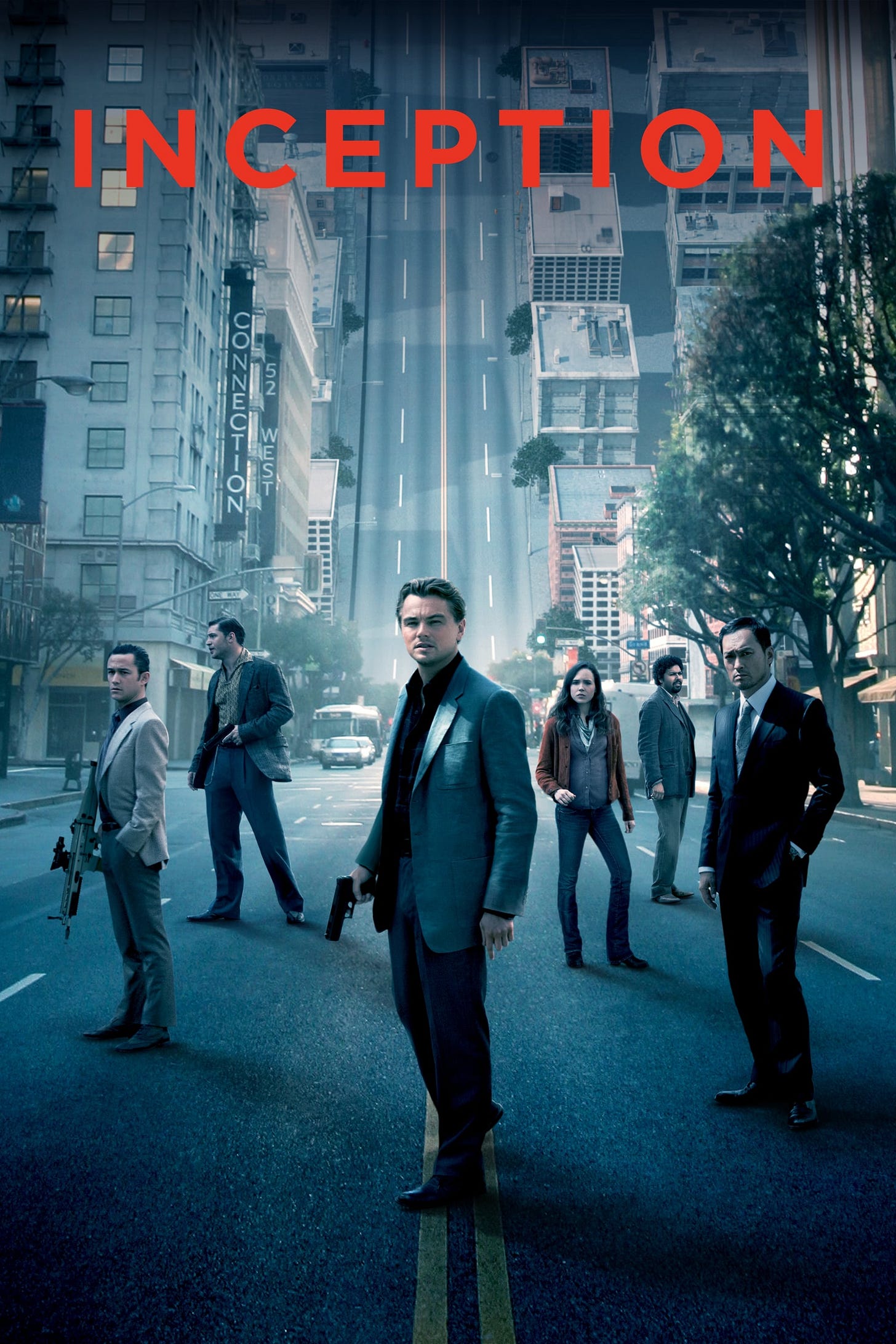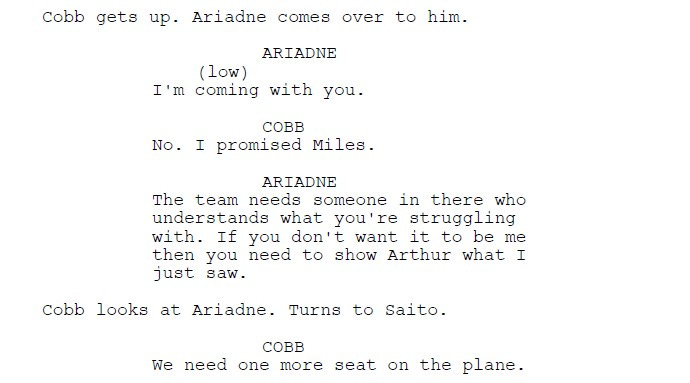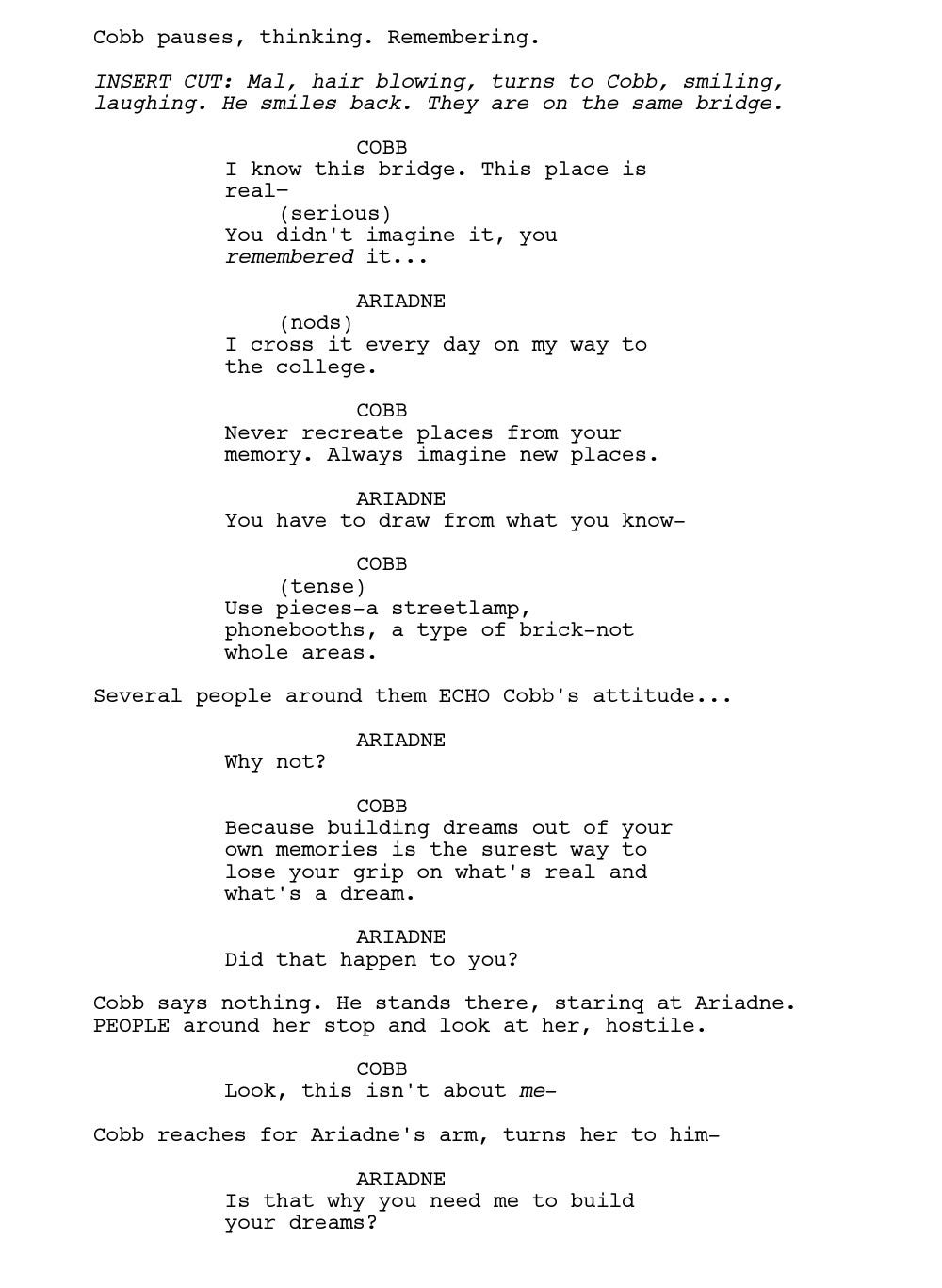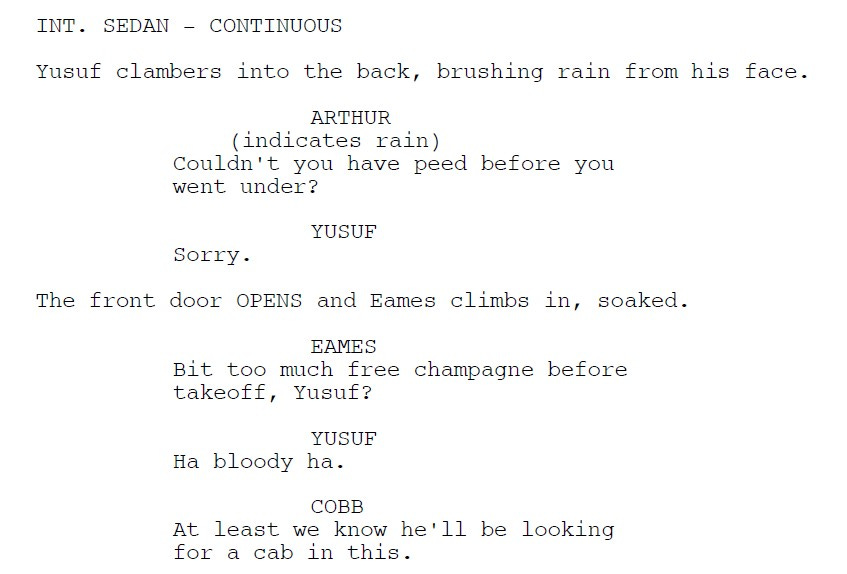Inception (2010) Script Review | #37 WGA 101 Greatest Scripts of the 21st Century
Christopher Nolan blends dream logic, sci-fi, and implausible high-octane action sequences to create that rare thing: an original, imaginative high-concept screenplay.
Logline: Cobb, a skilled thief who commits corporate espionage by infiltrating the subconscious of his targets, is offered a chance to regain his old life as payment for a task considered to be impossible: plant an idea in someone’s mind. But in his efforts to carry out the mission, a dangerous enemy anticipates Cobb’s every move.
Written by: Christopher Nolan
Pages: 146
Reading Inception is like watching a magician’s trick come to life: a pleasure to behold, and marvelous to see how it works on the page. It falls within the confines of the heist genre but is rooted in a world made possible by science fiction.
When a technology makes it possible to enter dreams, some have turned it to purposes for corporate espionage. One such person is Cobb. A thief who steals secrets from his targets’ dreams, Cobb is the best in the business. But a client, Saito, has an intriguing proposition: He wants Cobb to plant an idea into a person’s mind instead of extracting it. It’s called inception (hence, the script’s title). It’s not impossible, but it is extremely difficult. It is the ultimate heist. Standard stuff.
Despite the dangers, Cobb cannot resist the offer. See, back home, there’s an arrest warrant for Cobb; the authorities believe that he killed his wife, Mal. He didn’t— Mal killed herself, but in such a manner that it looked like he committed the crime. Now, he’s absent from the lives of his two small children, James and Phillipa. If Cobb pulls off the mission, Saito will make it possible for Cobb to return to America and reunite with them.
Every heist story needs an ace team. After Act 1 drops us into the world of dream theft, introduces Saito, Cobb, Arthur, and Mal as a projection of Cobb’s mind—and the story’s femme fatale antagonist— the lengthy Act 2 is the fun part in which Cobb must find his players. He already has his right-hand man in the form of the reliable Arthur, but he needs:
An architect to design the dream world;
A forger to play many parts in the dream world;
A chemist with a strong enough compound to create deep sleep in order to carry out the mission;
And Saito, already introduced, is the team’s financial backer.
For the chemist, Cobb selects Yusuf; for his forger, he picks an Englishman named Eames. But it’s the architect, Ariadne, who is the most important character for the purposes of this screenplay. Ariadne is a newcomer to this world; she is the audience surrogate. Cobb and Arthur can rattle off pages of exposition to her—and accordingly, us—that explain the rules of the world in a way that feels natural.
And there are quite a few rules.
As for the mission: the target is the heir to an energy empire and a rival to Saito’s own corporation. Robert Fischer. Saito wants Cobb to plant the idea in Fischer’s mind that it would be better to break up his father’s company. Saito wants this done so that his company can compete in the market (heist stories rarely have noble motives). They need 10 hours to pull off the job, so they charter a flight from Sydney to Los Angeles with an unknowing Fischer along for the ride. The job itself requires going at least three layers down into the mind, which only leads to further complications.
Almost immediately, the heist goes wrong. Fischer’s mind is ‘protected’ against dream extraction, and Saito is shot. That adds a new wrinkle. Normally, if a person dies in a dream, they wake up; but Yusuf’s dream drug is so potent that instead of waking up, the person will fall into a coma. Pressure mounts, a new plan is improvised, and the clock is ticking as the walls start closing.
Christopher Nolan, who wrote the script, doesn’t waste too much time on explaining how the technology works, apart from a brief mention that it was invented by the military for training soldiers. It exists, ‘dream theft’ is a thing, roll with it. Good call. After all, we come to stories not for mumbo-jumbo explanations but for the characters, and to see whether or not they will succeed in achieving their goals. His characters are a colorful lot. Arthur is the responsible straight man…
Eames is droll with a hint of straight-faced playfulness…
Yusuf offers a little levity…
Saito is rich…
And Ariadne, while being our entry to the story, is the heart of the script. As Cobb’s protégé, she quickly becomes privy to his inner demons and is concerned that he will jeopardize the mission. In fact, this is the reason why at the Midpoint on page 72, she convinces Cobb to include her in on the heist (she was earlier not going to be involved).
Since ensemble affairs like Inception requires spending time with these characters, a good rule of thumb is to pair up different characters in unique ways. For instance, Cobb spends a lot of time with Ariadne because he’s training her, but also because she helps him to see and think more clearly.
Meanwhile, the dynamic between Arthur and Eames offers opportunities for levity…
And few scenes with Arthur and Ariadne expand on the world’s possibilities and offer a hint of romance, (though it’s somewhat antiseptic since it never goes anywhere).
The rule of thumb for ensemble movies: match up characters with diverse personalities to create the most effective drama and conflict.
Nolan’s love for non-linear storytelling flourishes in Inception. It is largely straightforward, though a chunk of time is spent on flashbacks of Mal as Cobb remembers her; Nolan uses ‘INSERT CUT’ to avoid disrupting the flow or taking up too much space…
He also gets a chance to play around with time, juggling three timelines during the heist— called a Dream Layer— before three eventually becomes four when they go into a Dream Layer called Limbo, which is the place where the script opens before flashing back to the beginning. What’s impressive is that Nolan is able to pull it off without confusing the reader, since each timeline has to line up and hit the emotional beats at the same time.
The dreams in Inception are more utilitarian and rooted in reality than dreamy, for lack of a better word. But the dream world is a way to create spectacle in the action sequences, whether it’s turning a hallway into a zero-gravity arena for a fist-fight…
Or a freight train barreling through a street…
Or Paris folding in on itself, like origami. Other touches include a change in gravity in one Dream Layer tilting the glasses in a bar in a different Dream Layer; or a full bladder in the real world causing the dream world to be caught in a rainstorm.
The idea for dream theft initially occurred to Nolan when he was a school boy attending Haileybury in the mid-80s. It wasn’t in the form of a heist movie, though; it was in the form of a horror story. Freddy’s Nightmares, a TV spin-off about Freddy Krueger from A Nightmare on Elm Street, was an influence especially for the dream-within-a-dream and shared dreaming ideas. Falling asleep while listening to his Walkman inspired the idea of using music as a cue. Across a period of a decade, he worked on the script; the story had morphed closer to a straightforward noir, in the vein of The Maltese Falcon than Ocean’s Eleven, full of betrayals and double crosses. In this version, Cobb felt guilt over a dead business partner (hence the Maltese Falcon connection). But 80 pages into the script, Nolan stalled. Somehow, no matter what he tried, he couldn’t get it to work. In 2002, he put the script into a drawer and turned his attention to other projects.
Around the birth of his fourth child, Nolan suddenly felt acutely aware of the time he spent away from his family. What if instead of a dead business partner, Cobb felt guilty about his dead wife? And what if circumstances kept him away from raising his children? Heist movies are rarely supposed to be emotional, but this emotional aspect appealed to Nolan. Slowly, the story came unstuck.
At the same time, Nolan hit it big with the success of The Dark Knight; suddenly, he had a blank check to command substantial amounts of funding for any project he liked. Inception would never have worked on a small budget. Having proven his credentials, the timing was fortuitous. Here was his chance to go as big as he liked, especially on an original story! He wrote the script on spec and sold it to Warner Bros., a practice he has continued to date.
The emotional direction was aided by Leonardo DiCaprio, who prodded Nolan to push the script in a more character-driven direction. This led to months of rewrites all the way close to shooting, but the results, I think, paid off handsomely.
Another emotional storyline is the strained relationship between Fischer and Maurice, his dead father. In the dream, Cobb’s team almost do Fischer a kindness by causing him to reframe Maurice’s disappointment in his son due to his attempts to be like him instead of being his own person. There’s a parallel between Cobb’s yearning to be with his children and Maurice seemingly absent for most of Fischer’s childhood. I suspect that this is not accidental.
Other influences on Inception are the James Bond franchise; not just in its tone, but in one set piece involving a fortress atop a snowy mountain that pays homage to On Her Majesty’s Secret Service, a Bond flick that Nolan loves. He was also influenced by The Matrix and Dark City, two significant science fiction films from the 1990s, as well as two stories by Jorge Luis Borges, ‘The Circular Ruins’—about the intersection between dreams and reality— and ‘The Secret Miracle’— in which time freezes and allows a condemned man to finish his play right before he is killed by a firing squad.
Rule of thumb: Always be watching and reading other works from which you can borrow for your own stories. Imitation is the sincerest form of flattery.
Christopher Nolan is the rare filmmaker to be able to write and make original stories at a large scale. Inception, his first solo writing credit since Memento, is a study in how to write something as daring and tricky as Nolan has. First, you prove yourself as bankable. Second, find the emotional aspects of the script, come up with unique characters, and then write the fancy sequences. Any attempt to reverse-engineer it is a recipe for failure. There’s nothing quite like Inception out there, except perhaps The Matrix. Even in Nolan’s filmography, it remains unique. It will be a long time before anyone else creates something to match it.
Notes:
Shone, Tom (2020) | The Nolan Variations: The Movies, Mysteries, and Marvels of Christopher Nolan
Hiscock, John (July 01, 2010) | Inception: Christopher Nolan interview (The Telegraph)
















I appreciate this breakdown.